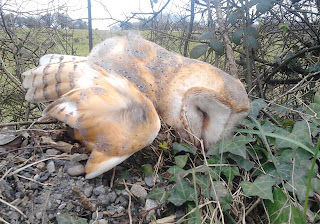A tragic sight, and a sad end to a beautiful animal. This Barn Owl was struck by a vehicle, just outside Duhallow, near Castleisland, two weeks ago.
Dead Barn Owl, struck by a vehicle near Castleisland, Co. Kerry, April 2013 (with thanks to Ed Carty).
In truth, Barn Owls suffer disproportionate road casualties, as their hunting methods – hunting low and slow (and with poor peripheral vision) – give a far higher chance of being struck by a fast moving vehicle than virtually any other species. Motorways and dual carriageways are particularly lethal to the species, and a 13 year study in Devon, England, showed that a busy main road will, "...cause the complete absence of breeding Barn Owls within 0.5km either side of the road, severe depletion... within 0.5 - 2.5km of the road and some depletion within 2.5-8km of the road."
Particularly lethal areas for Barn Owls (and other species) are where roads are 'embanked', ie., raised from the surrounding countryside, and which have little or no hedgerow, meaning that birds need to fly up and over the road, crossing it even lower than normal. By way of example, several dead Barn Owls were reported along the new stretch of 'improved' road near Knocknagashel in East Kerry, shortly after it opened some years ago. Much of that new road was embanked and lacked (and still lacks) any cover along its edges. Studies in England also showed that identifying and screening those embanked stretches of road with trees and/or wooden fencing can reduce or prevent Barn Owl road casualties by deflecting their flight path up and higher over the road. Wooden fencing has already been added to eg., new stretches of the M7 Limerick to Dublin motorway, and although this was done for noise abatement for local houses, it is often placed in exactly the most dangerous embanked stretches for Barn Owls, albeit accidentally. With very little extra effort and expense, further stretches could be made safe for local Barn Owls and other wildlife.
With a fairly heavily barred tail, the particular individual in the photo above looks to be a female, and as most Barn Owls will nest in their first year, it seems likely she was close to commencing nesting somewhere nearby. A real tragedy that she won't now have the chance.






